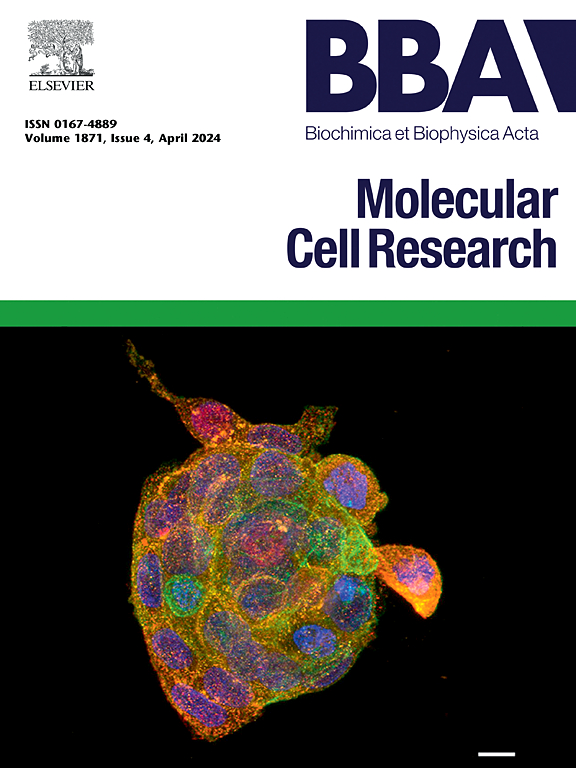小鼠线粒体类核的体内组成
IF 3.7
2区 生物学
Q1 BIOCHEMISTRY & MOLECULAR BIOLOGY
Biochimica et biophysica acta. Molecular cell research
Pub Date : 2025-04-15
DOI:10.1016/j.bbamcr.2025.119955
引用次数: 0
摘要
线粒体DNA (mtDNA)被压缩成称为线粒体类核(mt-nucleoids)的动态结构,线粒体转录因子A (TFAM)作为核心包装蛋白。我们培育了表达flag标记的TFAM蛋白的细菌人工染色体(BAC)转基因小鼠(TFAM - flagbac小鼠),在体内研究了mt-类核组成。重要的是,我们发现TFAM- flag蛋白是功能性的,并补充了纯合子TFAM敲除小鼠中野生型TFAM蛋白的缺失。我们从不同的小鼠组织中进行免疫沉淀实验,并通过蛋白质组学分析鉴定出12种蛋白作为核心mt-类核成分。其中8个蛋白对应mtDNA复制和转录因子,另外4个参与线粒体体组装。此外,我们使用Tfam-FLAGBAC小鼠鉴定了10种可能在线粒体RNA聚合酶耗尽时稳定TFAM-FLAG的蛋白,尽管缺乏mtDNA和诱导LONP1蛋白酶。最后,我们评估了由非常高水平的TFAM引起的mt-类核的变化,揭示了9个相互作用物,这些相互作用物可以抵消高水平的TFAM以维持活跃的mtDNA转录。总之,我们证明了Tfam-FLAGBAC小鼠是体内研究mt-类核组成的有价值的工具。本文章由计算机程序翻译,如有差异,请以英文原文为准。
In vivo composition of the mitochondrial nucleoid in mice
Mitochondrial DNA (mtDNA) is compacted into dynamic structures called mitochondrial nucleoids (mt-nucleoids), with the mitochondrial transcription factor A (TFAM) as the core packaging protein. We generated bacterial artificial chromosome (BAC) transgenic mice expressing FLAG-tagged TFAM protein (Tfam-FLAGBAC mice) to investigate the mt-nucleoid composition in vivo. Importantly, we show that the TFAM-FLAG protein is functional and complements the absence of the wild-type TFAM protein in homozygous Tfam knockout mice. We performed immunoprecipitation experiments from different mouse tissues and identified 12 proteins as core mt-nucleoid components by proteomics analysis. Among these, eight proteins correspond to mtDNA replication and transcription factors, while the other four are involved in the mitoribosome assembly. In addition, we used the Tfam-FLAGBAC mice to identify ten proteins that may stabilize TFAM-FLAG upon depletion of the mitochondrial RNA polymerase despite the absence of mtDNA and induction of the LONP1 protease. Finally, we evaluated the changes in mt-nucleoids caused by very high levels of TFAM unraveling nine interactors that could counteract the high TFAM levels to maintain active mtDNA transcription. Altogether, we demonstrate that the Tfam-FLAGBAC mice are a valuable tool for investigating the mt-nucleoid composition in vivo.
求助全文
通过发布文献求助,成功后即可免费获取论文全文。
去求助
来源期刊
CiteScore
10.00
自引率
2.00%
发文量
151
审稿时长
44 days
期刊介绍:
BBA Molecular Cell Research focuses on understanding the mechanisms of cellular processes at the molecular level. These include aspects of cellular signaling, signal transduction, cell cycle, apoptosis, intracellular trafficking, secretory and endocytic pathways, biogenesis of cell organelles, cytoskeletal structures, cellular interactions, cell/tissue differentiation and cellular enzymology. Also included are studies at the interface between Cell Biology and Biophysics which apply for example novel imaging methods for characterizing cellular processes.

 求助内容:
求助内容: 应助结果提醒方式:
应助结果提醒方式:


